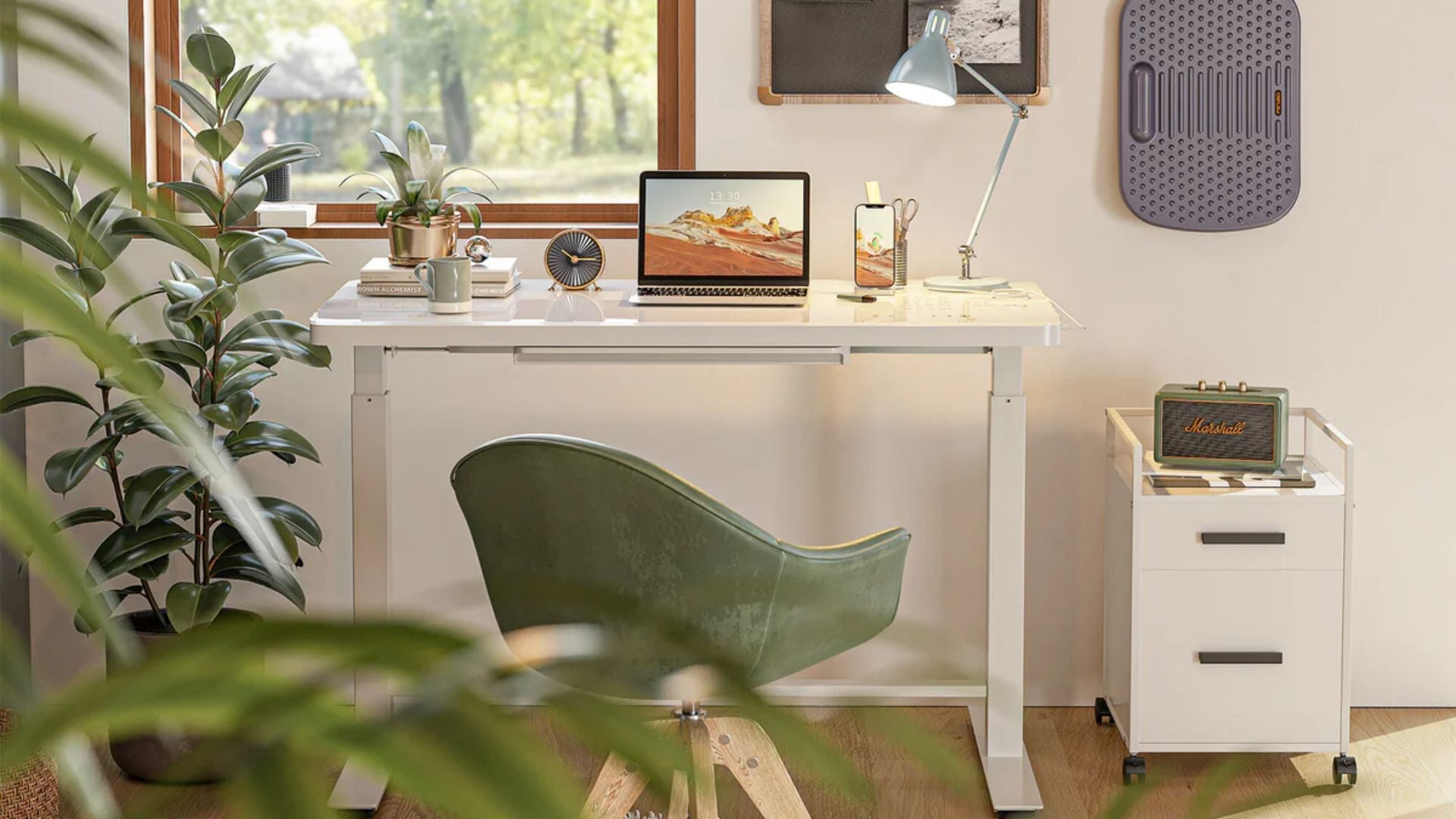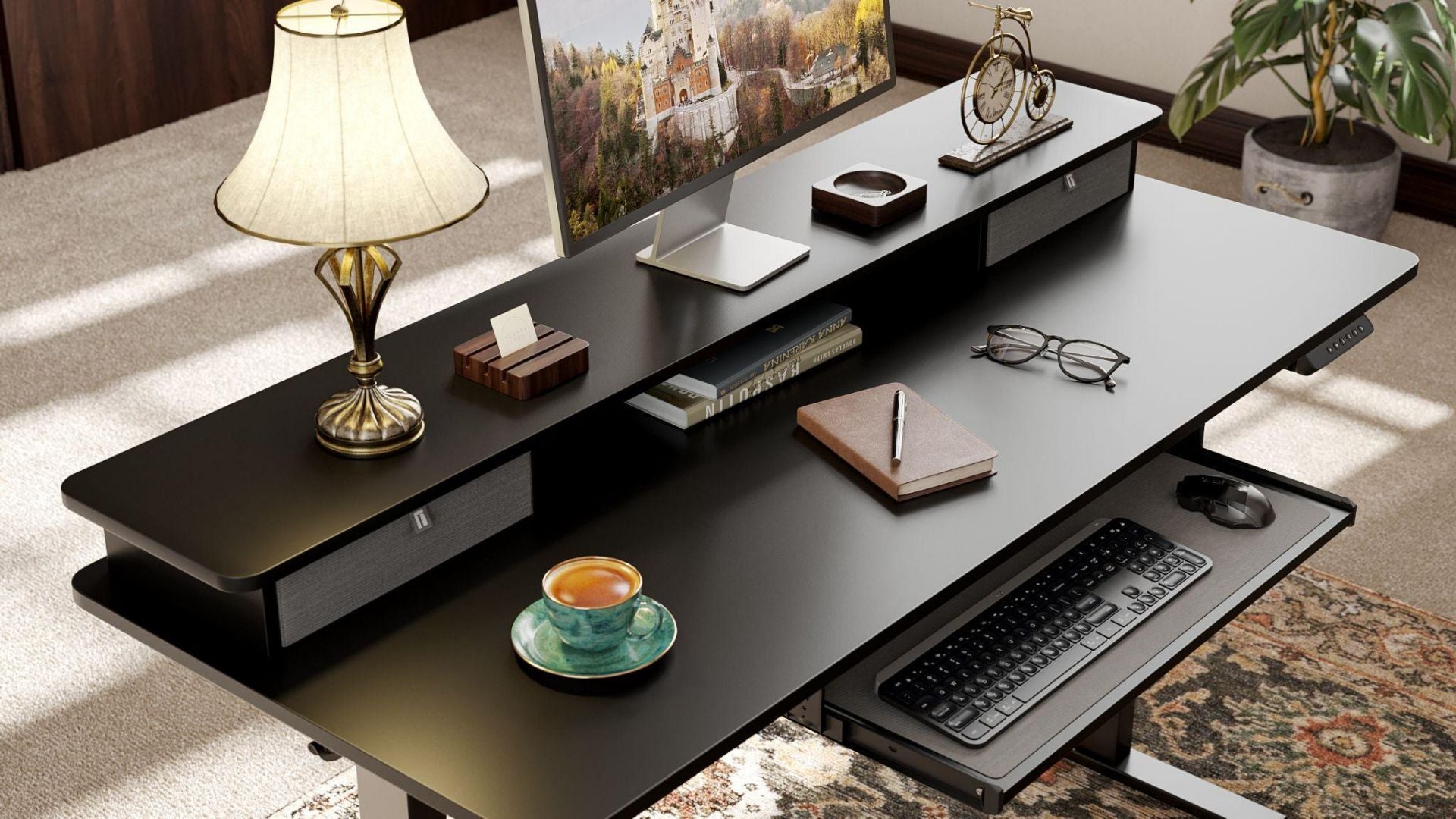Are you in the market for a new desk, but not sure what size to get? Desk dimensions are an important factor to consider when choosing a workspace that fits your needs and the space available. From standard office desks to standing desks, there are various sizes and shapes available on the market. Making sure you have the correct measurements is essential for productivity and comfort. In this blog post, we'll explore everything you need to know about standard desk dimensions, how to measure your desk correctly, tips for choosing the right size, and our top picks for office desks. Let's dive in!
Standard Desk Dimension for Office Desks
When it comes to office desks, there are standard dimensions that most manufacturers follow. The typical office desk size is around 60 inches wide, 30 inches deep, and 29 inches high. However, these measurements can vary depending on the manufacturer or your personal preference.
The width of a desk is crucial, as it determines how much workspace you will have available. A standard desk width ranges from 48 to 72 inches, while some executive desks may measure up to 90 inches wide. Keep in mind that if you're planning on having multiple monitors or other equipment on your desk, you may want to consider a wider option.
The depth of your desk also plays an important role in determining comfort and functionality. For standard office desks, the average desk depth typically ranges from 24 to 36 inches. If you work with larger documents or items like blueprints, opting for a deeper desk may be beneficial.
The height of your desk should align with your body's natural posture when sitting down at the computer and typing away comfortably for extended periods of time. Standard heights range between 28 and 30 inches tall; however, taller individuals might need something slightly higher than average so they don't hunch over their keyboard all day long.
Getting the right dimensions for an office table is essential because it provides ample space and promotes good posture, which leads to better productivity throughout the workday!
Standard Desk Dimensions for Standing Desks
Standing desks have become increasingly popular in recent years due to their perceived health benefits. When it comes to choosing a standing desk, getting the right dimensions is crucial for both comfort and ergonomics.
The standard height for a standing desk is around 30 inches, which allows most people to comfortably stand with their arms at a 90-degree angle while typing or using a mouse. However, this may not be suitable for everyone, as taller individuals may require higher desks, and shorter individuals can adjust standing desk height.
In addition to the height, it's also important to consider the width and depth of your standing desk. A wider surface area can accommodate multiple monitors or other work-related items, while deeper desks allow you to keep everything within reach without having to constantly lean over. The width of a standing desk is normally 48 to 60 inches, yet some desks may range from 40 to 72 inches. The standard depth for standing desks is 25 to 30 inches.
When measuring your ideal standing desk size, take into account any accessories you might need, such as keyboard trays or monitor arms, that can affect the overall dimensions of your workspace.
Ultimately, finding the right dimensions for your standing desk can help improve posture and reduce discomfort from prolonged periods of sitting.
The Importance of Getting Desk Dimensions Right

Getting the desk dimensions right is crucial for several reasons. Some of them are as follows:
Productivity:
Productivity is a crucial part of any job, and having the right desk dimensions can significantly impact your ability to focus and get things done. When you have a workspace that's too small or cluttered, it can be challenging to stay organized and productive.
On the other hand, if your desk is too large or poorly positioned, you may find yourself constantly shifting around in search of a comfortable position. This can lead to distractions and reduce your overall productivity levels.
Having a work environment with proper desk dimensions means that everything you need will be within easy reach without being cramped. You'll have enough space for all of your tools and documents while still maintaining an uncluttered workspace.
In addition to reducing physical discomfort, having the right desk setup can also improve mental clarity. When you're not distracted by discomfort or clutter, it's easier to concentrate on the task at hand and maintain focus throughout the day.
Investing in a workspace with appropriate dimensions is one of the most important steps you can take toward optimizing productivity in both short-term tasks and long-term projects alike.
Comfort and Ergonomics:
When it comes to choosing the right desk dimensions, comfort, and ergonomics should be at the top of your list. An uncomfortable desk can cause aches and pains that can lead to long-term health problems.
Ergonomics is all about designing products with people's needs in mind. A well-designed ergonomic desk will help you maintain good posture, reduce muscle strain, and increase productivity.
One important aspect of an ergonomic desk is its height. The ideal height for your desk depends on your height and the type of work you do. Your arms should rest comfortably on the surface of the desk without having to reach up or down.
Another important factor is the shape of your desk. L-shaped desks are great for those who need extra space for a computer or paperwork, while U-shaped desks are perfect if you have multiple monitors or need more surface area.
Your chair also plays a crucial role in ensuring proper ergonomics at your workstation. Look for chairs with adjustable heights, lumbar support, and armrests that allow you to rest your arms comfortably while typing.
Investing in an ergonomic workspace may cost more upfront but will save you money in medical bills and lost productivity due to discomfort later down the road.
How to Measure Your Desk?
When it comes to desk measurements, there are a few things you need to keep in mind. First, determine the purpose of the desk measurement: are you looking for the overall dimensions of the desk or just the surface area? Once you have that sorted, grab a tape measure and get started.
To measure the surface area of your desk, start by measuring its length from left to right. Then, measure its depth (front to back). Make sure you take into account any drawers or shelves that may protrude beyond the main body of the desk.
If you're looking for overall dimensions (including height), start by measuring from floor to desktop. This will give you an accurate measurement of how tall your desk is. To get width and depth measurements, follow the same steps as above.
It's important to note that if your desk has an irregular shape or angles, it may be more challenging to get accurate measurements. In this case, try breaking down each section into smaller rectangular shapes and measuring those individually. This may also be true for taking l shaped desk dimensions.
By taking precise measurements of your current workspace, you'll be better equipped when shopping for new desks and can ensure a good fit for both yourself and your office space limitations.
How To Choose The Standard Office Desk Size?

Choosing the standard office desk dimensions is crucial for maintaining optimal comfort and productivity in your workspace. Here are some tips to help you choose the right desk size:
Understand Your Workspace
Before selecting a desk size, it's important to understand your workspace. Take a moment to assess the area where you plan to place your new desk. Is there enough physical space for the desk size you have in mind? If you have a small space, then you should look for standard small desk dimensions, or vice versa. Consider other factors as well, such as lighting and noise levels.
It's also essential to think about how you'll be using the desk. Will you primarily be working on a computer or doing paperwork? This can affect the ideal height and depth of your desk.
Additionally, take into account any storage needs that may arise from utilizing this workspace. You may need additional shelving or drawers alongside your new desk.
Consider potential future changes to this space when making decisions regarding choosing an appropriate sized workspace. All of these aspects are crucial elements that should factor into determining which desk dimensions will work best for both yourself and your environment.
Choosing The Ideal Desk Height
The ideal desk height is dependent on a few factors, including the height of the user, the type of work being done, and the amount of space available. For general use, it is recommended that desks be adjusted to a height that allows for good posture and a comfortable reach. The typical desk size is usually between 28 inches and 30 inches. If you are taller or shorter than average, you may need to adjust your desk accordingly. Additionally, if you are working with special equipment or doing tasks that require more detailed movements, such as art or drafting projects, a higher or lower desk may be necessary. Finally, if space is limited, you may need to opt for a standing desk or one with adjustable legs to fit your needs. Standard standing desk dimension also depend on your needs.
Choosing The Ideal Desk Width
When choosing the ideal desk width, it is important to consider how much space you need for your computer, monitor, and other equipment. If you plan to use the desk for writing or drawing, you may need a wider surface area. Additionally, if you will be using several monitors on your desk, the standard width of a desk should be wide enough to accommodate them comfortably. Consider measuring the space where you plan to place your desk so that you can choose the right size. The average desk width depends on its usability.
Choosing The Ideal Desk Depth
When selecting the ideal desk depth, you should consider the size of your office space, the type of activities you will be performing at the desk, and how many people will be using it. The typical desk depth should be between 24-30 inches, depending on the room size and activities that need to be performed. It is important to have enough room for all your necessary items, such as a computer, printer, monitor, and other accessories. You also want to make sure that there is enough space for you to comfortably work without being cramped or restricted.
Average Desk Dimensions
By now, you should have a better idea of how to choose the best standard desk size for your workspace. It's essential to understand your needs and preferences while keeping in mind the ideal width, depth, and length of a desk.
To help you with the process, here are some average desk dimensions that you can use as a guide:
- Standard Desk Height Dimensions: 29 inches
- Standard Desk Width: 48 inches
- Standard Desk Depth: 22 inches
Keep in mind that these are typical desk dimensions and may not be suitable for everyone. If you're taller or shorter than average, or if you have specific work requirements such as extra space for dual monitors or documents, then it's important to customize your desk accordingly.
Types of Desks
When it comes to choosing a desk, there are many types of desks to consider. The type of desk you choose will depend on your needs and preferences. The average desk size varies with the type of desk. Here are some popular types of desks:
Standard Desk Dimensions: Writing Desk
Dimensions: 28 inches – 30 inches x 36 inches – 40 inches
A writing desk is a simple, compact desk that's perfect for small spaces. It usually has a flat surface and of small desk size with minimal storage space. This desk style is usually quite old and frequently features storage areas for pens and paper. It has drawers beneath and is normally not overly busy or large.
Standard Desk Dimensions: Computer/ Gaming Desk
Dimensions: 50 inches x 25 inches
A computer desk features ample workspace for your monitor, keyboard, mouse and other computing accessories. Computer desk dimensions vary with the size of your workstation. These desks are often big enough to fit at least two monitors, which is why they frequently have corners that are twice as long as regular desks.
Standard Desk Dimensions: Executive Desk
Dimensions: 60 inches ×30 inches
An executive desk is designed for people who need plenty of workspace and storage space. It often has drawers on both sides and may have additional features such as built-in bookcases or file cabinets.
Standard Desk Dimensions: Credenza desk
Dimensions: Varies, but oblong and bulky
A credenza desk serves as a location to store and organize office-related paperwork. It is rarely used by a single individual, but rather by a group of people. It holds files and keeps everything organized.
A credenza desk is often large and stocked with drawers. On the bottom and occasionally on top, like a hutch. For keeping papers, there is generally enough space in a variety of sections.
Standard Desk Dimensions: Standing Desk
Dimensions: Height 29 to 30 inches tall, Width: 48 - 72 inches, Depth: 24- 36 inches deep
A standing desk allows you to work while standing up rather than sitting down all day long which can help prevent back pain caused by extended sitting periods. Standing desk size is usually adjustable, so you can change its height as per your convenience.
Standard Desk Dimensions: L-Shaped Desks
L-shaped desks give you extra room if you have multiple monitors or need more desktop space in general. L shaped desk sizes vary according to requirements.
Each type of desk offers unique benefits, so be sure to consider what's most important to you before making your decision!
Top 04 Office Desks for Office Spaces
Choosing the right office desk is crucial for your productivity and comfort. Here are four top office desks to consider with standard office desk dimension:
1. Brasa Electric Standing Desk with Upper Double Drawer
This desk offers a spacious surface area, an adjustable height, and a sleek design. This desk has a monitor stand, a storage cubicle, and two drawers. It is the best value-for-money device with three pre-set buttons.
2. Electric Standing Desk

It is the another best standing desk, with minimal design and maximal comfort. This desk has a basic frame and only an up and down button. This desk is the best option for those who are looking for a simple yet elegant standing desk.
3. Mid-Century Modern Electric Standing Desk with Drawers & Keyboard Tray

If you want to take your work station's aesthetics and productivity to the next level, you can consider this desk. This FEZiBO standing desk's clean lines, delicate accents, and ergonomic keyboard tray in the shape of an arc perfectly capture the Mid-Century Modern design aesthetic.
The whole-piece desk board's magnificent black walnut finish does a great job of evoking a warm and stylish atmosphere, transforming your workspace into a timeless enclave that fits right in with any contemporary décor scheme.
This desk has an Up and Down button for momentary control, three Hight’s memory preset buttons, and automotive anti-collision technology.
4. Triple Motor L-shaped Standing Desk V2
Our triple motor l-shaped standing desks are of the same high quality as those sold for more than $1000. However, we provide cheaper prices in order to make our workstations "small profit, big sale" and more affordable. This desk is adjustable for both the left and right sides, and it is also suitable for different corner desk dimensions.
With these four great choices available on the market today, you'll be sure to find one that suits your needs!
Conclusion
Choosing the right desk size is crucial for maximizing productivity and comfort in your workspace. Whether you are looking for an office desk or a standing desk, understanding standard desk sizes can help you make an informed decision that suits your needs.
When it comes to selecting the perfect desk, consider factors such as space availability, work habits, ergonomics, and personal preferences. Make sure to measure your available space accurately and choose a suitable design that complements your style and workflow.
By taking these considerations into account, along with our tips on choosing the right size of desks and our top four recommended office desks for various spaces, we hope this article has helped guide you towards finding the ideal workspace solution.
Remember, getting the right measurements isn't just about fitting furniture into a room; it's also about ensuring that everything fits together seamlessly to create a comfortable working environment. So take care when measuring up and don't rush into any decisions; after all, this is where you'll be spending most of your workday!





